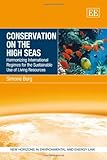Conservation on the high seas : harmonizing international regimes for the sustainable use of living resources / Simone Borg.
Series: New horizons in environmental and energy lawPublisher: Cheltenham, UK : Edward Elgar, [2012]Copyright date: ©2012Description: xix, 313 pages ; 24 cmContent type:- text
- unmediated
- volume
- 9780857935632 (hardback)
- 0857935631 (hardback)
- 9780857935649 (ebook)
- 085793564X (ebook)
| Item type | Current library | Home library | Collection | Call number | Materials specified | Copy number | Status | Date due | Barcode | |
|---|---|---|---|---|---|---|---|---|---|---|
| AM | PERPUSTAKAAN UNDANG-UNDANG | PERPUSTAKAAN UNDANG-UNDANG KOLEKSI AM-P. UNDANG-UNDANG | - | C39.21.B647 2 (Browse shelf(Opens below)) | 1 | Available | 00002128823 |
Includes bibliographical references (pages 284-297) and index.
Introduction -- Regulatory jurisdiction over living resources on the high seas -- The obligation to take conservation measures for living resources on the high seas -- Specialized conservation measures for particular species on the high seas -- The main constituent elements of conservation regimes for living resources on the high seas -- Enforcement jurisdiction on the high seas and the conservation of living resources -- The conservation of living resources on the high seas : constituent element for compliance and enforcement -- Conclusion.
This timely book discusses various international norms that qualify the right, which all states have to access and exploit living resources in marine areas beyond national jurisdiction, in order to promote the conservation of such species. An intricate body of norms has accumulated over the last few decades, consisting of prior and subsequent rules addressing the same issues, as well as a number of specialized rules that supplement more general ones. However, this process has also exposed the fragmentation of the relevant international regimes, with evolving and diverse interpretations of the same legal terms fine-tuning or qualifying earlier treaties. Uncertainty prevails as to how these norms interrelate with each other. The book assesses to what extent the harmonization of these international regimes is possible. It highlights current trends and developments which aim at better coherence, and discusses legal techniques that could serve to harmonize both the objectives of these international norms and their scope of applicability. The author also demonstrates that in some cases, gaps and conflicts in the existing legal framework cannot be simply'interpreted away' but require the further development of international law in order to be resolved properly. -- from http://www.booktopia.com.au (July 10, 2014).
There are no comments on this title.

